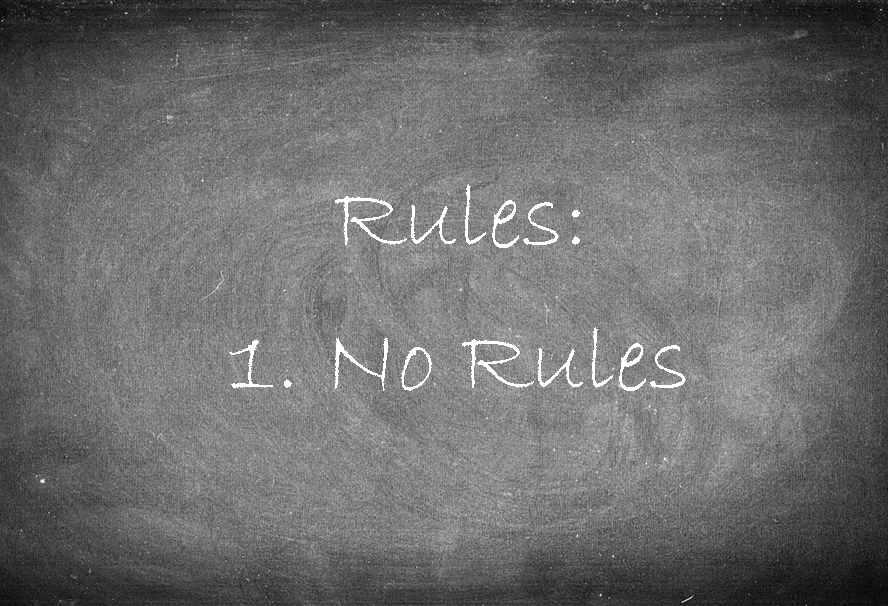Rules
I was never a person who did well with rules that I didn’t understand. My parents can attest to the fact that I was never an enthusiastic follower of rules. If I didn’t have a legitimate reason for why there was a rule, I didn’t think it was important that I followed it. I drove my parents crazy.
Math, as we all know, is just filled with rules. Back when I was in school we were given a math rule to follow with little to no explanation and then given a sheet of what seemed like a million practice problems to do. We could get them right if we just followed the rules. But, as I previously stated, I was not one to do this. I was that kid who was continuously asking, “Why?” To my all too often disappointment, I was told over and over that it was just the way math was.
I refused to accept that math rules were just arbitrary things written by some ancient math dictator. They had to make sense. I needed for them to make sense. I started doing my own experiments with the rules to see what would happen if I didn’t follow them. Although I discovered that the rules had mathematical reasoning behind them, I felt as if I had learned more than my peers because I knew why the rule was written. If there was a rule that I couldn’t figure out on my own, my teachers were usually not much help. They knew how to teach the rule, but didn’t usually understand it any more than I did. This frustrated me to no end.
Even in college I heard, “Just do it the way I showed you.” I swore as an education major that I would never ask my students to do something that I couldn’t explain to them. I was determined that my students would know the reasoning behind all the rules.
During my first several years as an elementary school teacher, I struggled with balancing the curriculum that the district handed me with the desire for my students to understand math and not just memorize rules. I dove into the works of Marilyn Burns and John Van de Walle. I read everything I could find that they wrote and replaced curriculum lessons with activities from their books. Since that time, my district has decided to write their own curriculum that stresses conceptual knowledge over procedural memorization. I love it!!
If you don’t understand the difference, consider this example. When you were little, I’m sure your mother told you not to touch the stove because it was “hot.” She didn’t spend time explaining what that meant, but expected you to obey. Think about which is a more powerful lesson, listening to your mom or touching the stove and learning what “hot” meant for yourself.
Math is the same. Math rules are just generalizations that mathematicians have discovered through the years. They aren’t wrong, but memorizing them doesn’t give students a true understanding of the math they are trying to do.
For example, the rounding poem is the way many teachers use to teach their students to round numbers. If you are not familiar with this poem here it is.
Find the digit
Look right next door.
Five or more
Raise the score.
Four or less
Let it rest.
I’m sure there are several other versions out there, but they all say basically the same thing. It is just a procedure written in a rhyming format. The problem comes in if you ask a student why 38 rounds to 40. You get an answer along the lines of “8 is more than 5” or they will recite the poem to you. They don’t understand that 38 rounds to 40 because 38 is closer to 40 than 30.
This is why it is more powerful to have students use a number line to round. They actually see that 38 is closer to 40 on the line. If they get enough time to explore rounding on the number line, they will discover those generalizations from the poem themselves. They will see over and over that when the number in the next place is 5 or higher you round up to the next place and when it’s 4 or less you stay where you are.
I cannot effectively describe the excitement in the room when they make these generalizations for themselves. It is so much more powerful than just memorizing a poem. They truly understand the math concept and are more likely to retain that information long term.
I have heard from teachers, “I show them the number line and explain to them why the poem works, so they understand it.” While I admit that they may have some understanding of the generalization, it is nowhere near as powerful as personal exploration and discovery.
Over the summer I will be blogging about several other common rules and tricks that should be buried in the mathematical graveyard.


